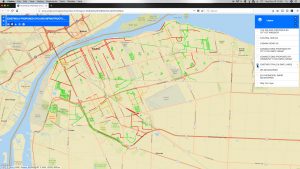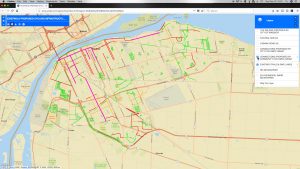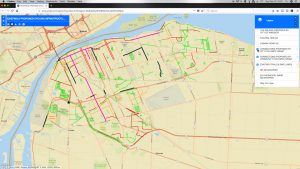Integrated bike network not in the cards yet

There is little agreement on where $1.7 million in provincial grants should be spent. Singage of bicycle path ending in Dougall Street. Photo by Bernard De Vaal.
Whether you prefer riding with the breeze in your hair on the Riverside Drive waterfront trail or just love the sound of leaves rustling while pedaling on the Ganatchio Trail, Windsor’s leisure bike routes are a feast for bike lovers. Cycling to work however, is a completely different type of adventure.
The City of Windsor applied to the Ontario Municipal Cycling Infrastructure Program with what it calls 13 “shovel ready” projects. It successfully secured $1.7 million in much needed funding for the city’s disjointed cycling network.
There is little agreement on where this money should be spent.
The funds were made available by the province from carbon emission taxes. The projects that municipalities submitted, had to go towards raising their green footprint.
“The proposal was done in conjunction with Windsor Bicycling Committee who gave us some of their suggestions and also council added a couple from their list as well,” says Dwayne Dawson, executive manager of operations in Windsor.
Despite the broad community participation, the projects will not offer “a visible and connected cycling network that is easily accessible, safe and actively used by all types of cyclists,” as indicated in a summary of the city’s Bicycle Use Masterplan Network (BUMP).
The city has done a lot for cycling. It launched several successful initiatives such as the Windsor police bicycle registry, bicycle maintenance stations and the bike and bus transport facilities.
In spite of these concessions, current census data shows that only 1.1 per cent of Windsorites commute to work on bicycles.
Lori Newton, executive director of Bike Windsor Essex says they surveyed almost 1000 residents on what they thought “cycle commuter dollars” should be spent on.
“Well we don’t have an integrated cycling network,” Newton said. “What we have is a lot of disjointed unconnected cycling infrastructure that residents speak about frequently and complain about how difficult it is getting around the city on a bicycle.”
She further says that the central reason most respondents cited for not commuting to work on bicycles, are safety concerns.
One flash point topic has been the Dougall death trap. A 2013 council proposal to have the very dangerous 1 kilometer bottleneck restructured, was never undertaken. It was due to the costs as well as parts of the land not belonging to the city, but to Canadian Pacific Railway.
“Because I drove through the Dougall death trap for many many years and it was never fun or an enjoyable experience,” said Oliver Swainson, a local cyclist who commutes to work. “I’d definitely like to see something done there.”
Dwayne Dawson, executive manager of operations in Windsor is frank about why projects like these are still lying dormant.
“We have a high range of projects that we can spread the money over, but obviously we have much more need than we have funding for right now,” he said.
To understand what the needs of the community are and what the projects are that the city have given the green light to, one needs to look at a map.
Bike Windsor Essex created an interactive online map showing existing and proposed cycling infrastructure.
Multi-use paths are marked in green and city street commuting routes in red.

In pink are connections proposed by the commuters surveyed by Bike Windsor Essex.

The programs proposed by Windsor Public Works are indicated in black.

The projects the city will implement show a notable fractured connectivity. The ideal pink routes, which will allow cyclists to commute safely on continuous bike paths, will remain pipe dreams for very practical reasons.
“The existing roads are only so wide so, you have to deal with existing parking considerations and a lot of times it doesn’t leave room with the parked cars for proper cycling facilities,” said Dawson.
Newton understands the issues.
“These however are very large projects that need environmental assessments and would probably not be appropriate for this sort of funding,” she said. “Whichever way the $1.7 million is spent, it will make headway towards a vision of integrated transport.”


